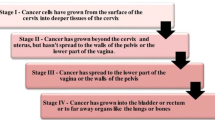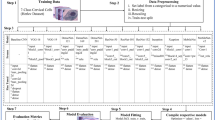Abstract
Cervical cancer is one of the fastest growing global health problems and leading cause of mortality among women of developing countries. Automated Pap smear cell recognition and classification in early stage of cell development is crucial for effective disease diagnosis and immediate treatment. Thus, in this article, we proposed a novel internet of health things (IoHT)-driven deep learning framework for detection and classification of cervical cancer in Pap smear images using concept of transfer learning. Following transfer learning, convolutional neural network (CNN) was combined with different conventional machine learning techniques like K nearest neighbor, naïve Bayes, logistic regression, random forest and support vector machines. In the proposed framework, feature extraction from cervical images is performed using pre-trained CNN models like InceptionV3, VGG19, SqueezeNet and ResNet50, which are fed into dense and flattened layer for normal and abnormal cervical cells classification. The performance of the proposed IoHT frameworks is evaluated using standard Pap smear Herlev dataset. The proposed approach was validated by analyzing precision, recall, F1-score, training–testing time and support parameters. The obtained results concluded that CNN pre-trained model ResNet50 achieved the higher classification rate of 97.89% with the involvement of random forest classifier for effective and reliable disease detection and classification. The minimum training time and testing time required to train model were 0.032 s and 0.006 s, respectively.










Similar content being viewed by others
References
Wong K, Chen J (2018) Advances in artificial intelligence in biomedical image analysis. Australas Phys Eng Sci Med 41:1075
Wong KK, Deng X, Ng EY (2019) A special section on medical data analysis based on image and signal processing with machine learning application in cardiology. J Med Imaging Health Inform 9(5):857–859
Wong KKL, Liu Z, Zou Q (2019) Multi-objective optimization and data analysis in informationization. Computing 221:495–498
Casadei R, Fortino G, Pianini D, Russo W, Savaglio C, Viroli M (2019) A development approach for collective opportunistic Edge-of-Things services. Inf Sci 498:154–169
Casadei R, Fortino G, Pianini D, Russo W, Savaglio C, Viroli M (2019) Modelling and simulation of opportunistic IoT services with aggregate computing. Future Gener Comput Syst 91:252–262
Hu Z, Tang J, Wang Z, Zhang K, Zhang L, Sun Q (2018) Deep learning for image-based cancer detection and diagnosis—a survey. Pattern Recogn 83:134–149
Khan S, Islam N, Jan Z, Din IU, Rodrigues JJC (2019) A novel deep learning based framework for the detection and classification of breast cancer using transfer learning. Pattern Recogn Lett. https://doi.org/10.1016/j.patrec.2019.03.022
Rodrigues MB, Nóbrega RVMD, Alves SSA, Filho PPR, Duarte JBF, Sangaiah AK, Albuquerque VHCD (2018) Health of things algorithms for malignancy level classification of lung nodules. IEEE Access 6:18592–18601. https://doi.org/10.1109/ACCESS.2018.2817614
Masoumi H, Behrad A, Pourmina MA, Roosta A (2012) Automatic liver segmentation in MRI images using an iterative watershed algorithm and artificial neural network. Biomed Signal Process Control 7(5):429–437. https://doi.org/10.1016/j.bspc.2012.01.002
Zhen X, Chen J, Zhong Z, Hrycushko B, Jiang S, Albuquerque K, Gu X (2017) Exploring deep convolution neural networks with transfer learning for rectum toxicity prediction in cervical cancer radiotherapy. Brachytherapy 16(3):S33–S34
Tareef A, Song Y, Huang H, Wang Y, Feng D, Chen M, Cai W (2017) Optimizing the cervix cytological examination based on deep learning and dynamic shape modeling. Neurocomputing 248:28–40
Xia J, Chen H, Li Q, Zhou M, Chen L, Cai Z et al (2017) Ultrasound-based differentiation of malignant and benign thyroid nodules: an extreme learning machine approach. Comput Methods Progr Biomed 147:37–49
Lan K, Wang DT, Fong S, Liu LS, Wong KK, Dey N (2018) A survey of data mining and deep learning in bioinformatics. J Med Syst 42(8):139
Sun G, Li S, Cao Y, Lang F (2017) Cervical cancer diagnosis based on random forest. Int J Performabil Eng 13:446–457
Chen W, Gou S, Wang X, Li X, Jiao L (2018) Classification of PolSAR images using multilayer autoencoders and a self-paced learning approach. Remote Sens 10(1):1–17. https://doi.org/10.3390/rs10010110
Almubarak HA, Stanley RJ, Long R, Antani S, Thoma G, Zuna R, Frazier SR (2017) Convolutional neural network based localized classification of uterine cervical cancer digital histology images. Procedia Comput Sci 114:281–287
Gumaei A, Hassan MM, Hassan MR, Alelaiwi A, Fortino G (2019) A hybrid feature extraction method with regularized extreme learning machine for brain tumor classification. IEEE Access 7:36266–36273
Chatterjee R, Maitra T, Islam SH, Hassan MM, Alamri A, Fortino G (2019) A novel machine learning based feature selection for motor imagery EEG signal classification in Internet of medical things environment. Future Gener Comput Syst 98:419–434
Cauteruccio F, Fortino G, Guerrieri A, Liotta A, Mocanu DC, Perra C, Vega MT (2019) Short-long term anomaly detection in wireless sensor networks based on machine learning and multi-parameterized edit distance. Inf Fus 52:13–30
Tang R, Fong S (2018) Clustering big IoT data by metaheuristic optimized mini-batch and parallel partition-based DGC in Hadoop. Future Gener Comput Syst 86:1395–1412
Marinho LB, de MM Nascimento N, Souza JWM, Gurgel MV, Rebouças Filho PP, de Albuquerque VHC (2019) A novel electrocardiogram feature extraction approach for cardiac arrhythmia classification. Future Gener Comput Syst 97:564–577
Gupta N, Gupta D, Khanna A, Rebouças Filho PP, de Albuquerque VHC (2019) Evolutionary algorithms for automatic lung disease detection. Measurement 140:590–608
Iwashita AS, de Albuquerque VHC, Papa JP (2019) Learning concept drift with ensembles of optimum-path forest-based classifiers. Future Gener Comput Syst 95:198–211
Sharma P, Gupta A, Aggarwal A, Gupta D, Khanna A, Hassanien AE, de Albuquerque VHC (2018) The health of things for classification of protein structure using improved grey wolf optimization. J Supercomput 1–16
Zhang L, Lu L, Nogues I, Summers RM, Liu S, Yao J (2017) Deeppap: deep convolutional networks for cervical cell classification. IEEE J Biomed Health Inform 21(6):1633–1643
Dourado CM Jr, da Silva SPP, da Nóbrega RVM, Barros ACDS, Rebouças Filho PP, de Albuquerque VHC (2019) Deep learning IoT system for online stroke detection in skull computed tomography images. Comput Netw 152:25–39
Tiwari P, Melucci M (2018) Towards a Quantum-Inspired framework for binary classification. In: Proceedings of the 27th ACM International Conference on Information and Knowledge Management. ACM
Tiwari P, Melucci M (2018) Multi-class classification model inspired by quantum detection theory. arXiv preprint arXiv:1810.04491
Tiwari Prayag et al (2018) Detection of subtype blood cells using deep learning. Cogn Syst Res 52:1036–1044
Gochhayat SP, Kaliyar P, Conti M, Tiwari P, Prasath VBS, Gupta D, Khanna A (2019) LISA: lightweight context-aware IoT service architecture. J Clean Prod 212:1345–1356
Garg S, Singh A, Batra S, Kumar N, Obaidat MS (2017) EnClass: ensemble-based classification model for network anomaly detection in massive datasets. In: GLOBECOM 2017–2017 IEEE Global Communications Conference. IEEE, pp 1–7
Garg S, Singh A, Kaur K, Aujla GS, Batra S, Kumar N, Obaidat MS (2019) Edge computing-based security framework for big data analytics in VANETs. IEEE Netw 33(2):72–81
Garg S, Singh A, Kaur K, Batra S, Kumar N, Obaidat MS (2018) Edge-based content delivery for providing qoe in wireless networks using quotient filter. In: 2018 IEEE International Conference on Communications (ICC). IEEE, pp 1–6
Garg S, Kaur K, Kumar N, Batra S, Obaidat MS (2018) HyClass: hybrid classification model for anomaly detection in cloud environment. In: 2018 IEEE International Conference on Communications (ICC). IEEE, pp 1–7
Author information
Authors and Affiliations
Corresponding author
Additional information
Publisher's Note
Springer Nature remains neutral with regard to jurisdictional claims in published maps and institutional affiliations.
Rights and permissions
About this article
Cite this article
Khamparia, A., Gupta, D., de Albuquerque, V.H.C. et al. Internet of health things-driven deep learning system for detection and classification of cervical cells using transfer learning. J Supercomput 76, 8590–8608 (2020). https://doi.org/10.1007/s11227-020-03159-4
Published:
Issue Date:
DOI: https://doi.org/10.1007/s11227-020-03159-4




